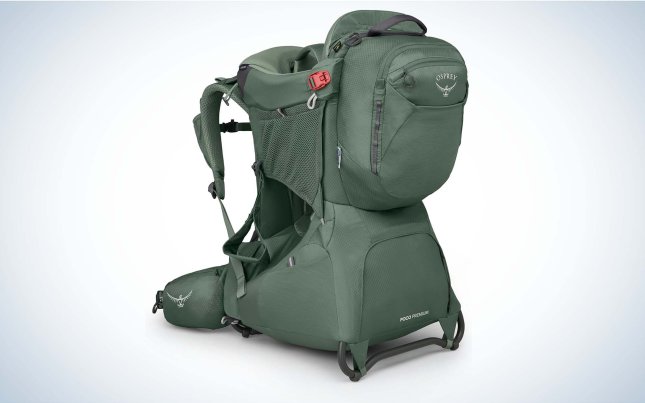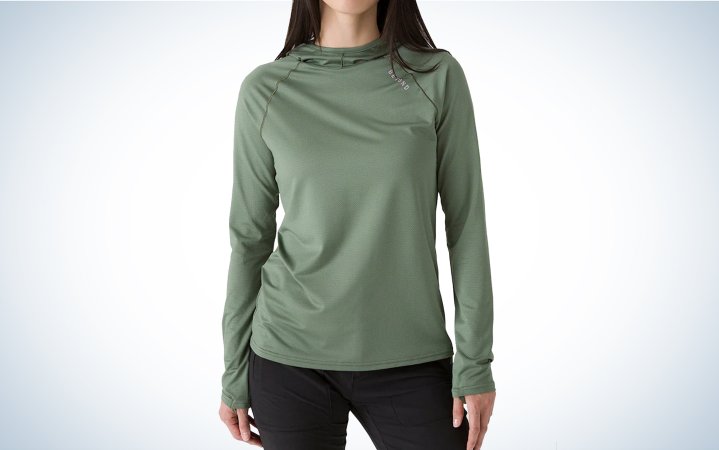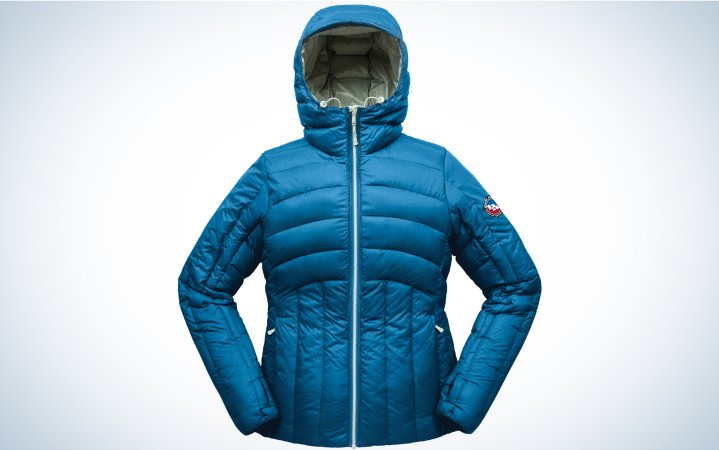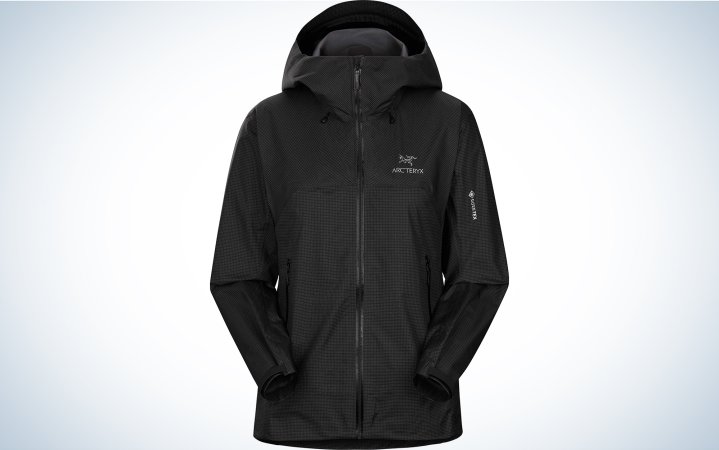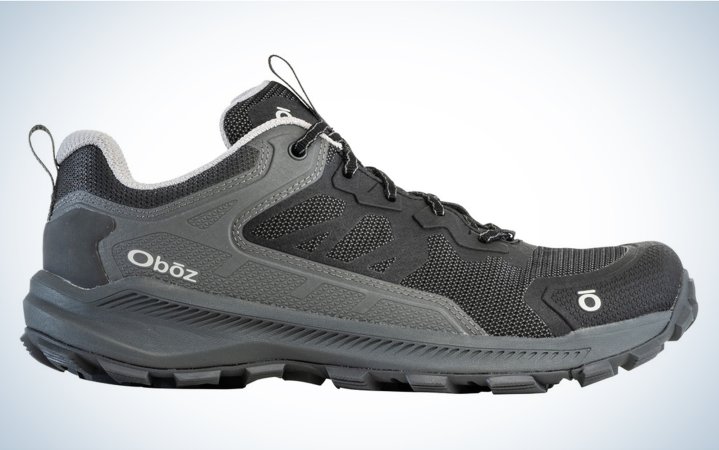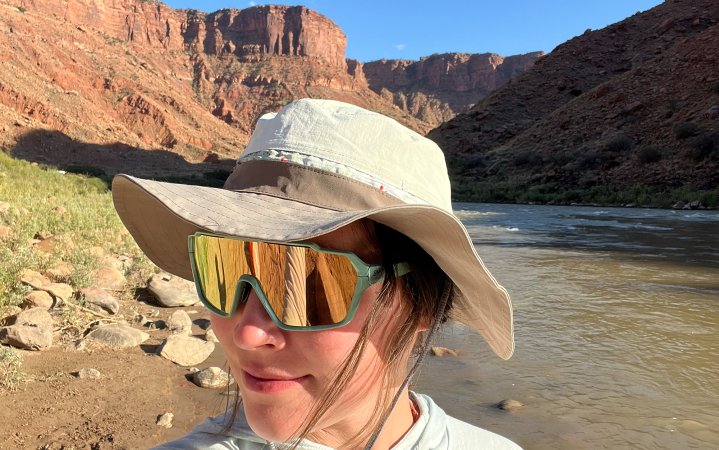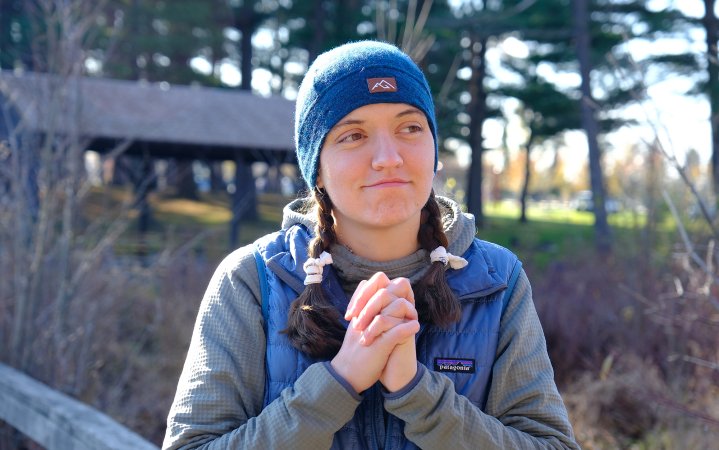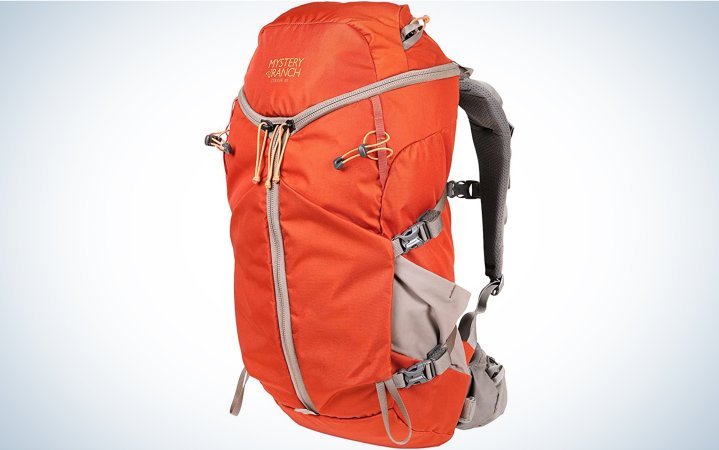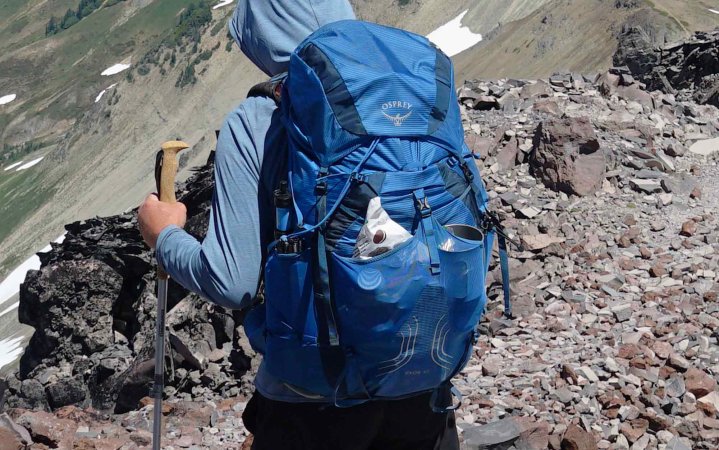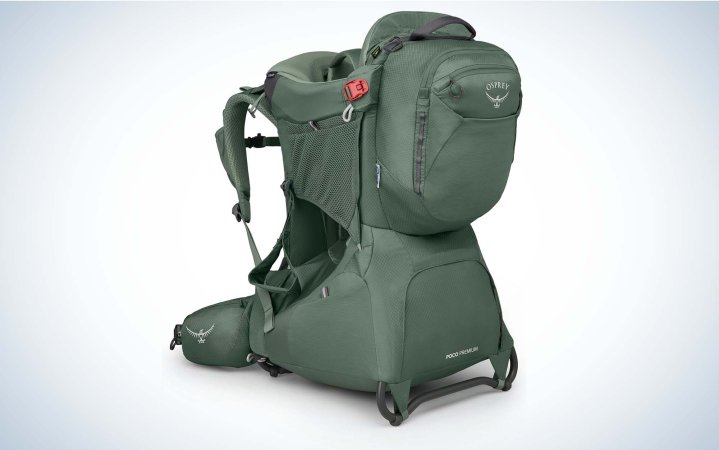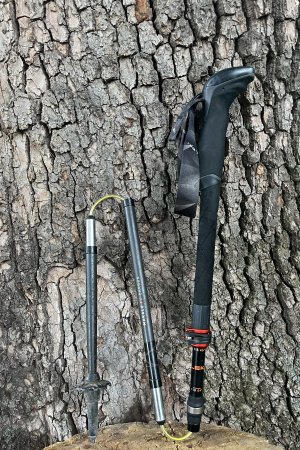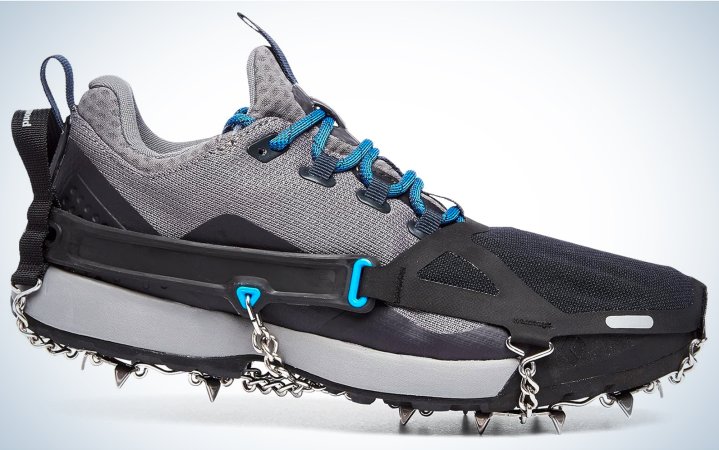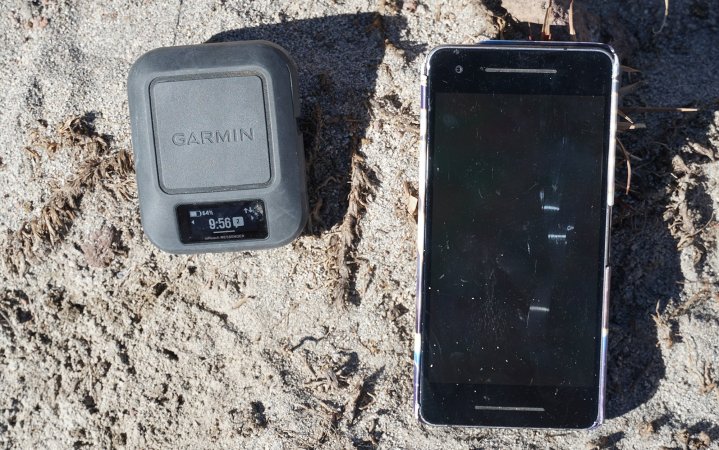We may earn revenue from the products available on this page and participate in affiliate programs. Learn More ›
At Outdoor Life, we have our hiking kits pretty dialed. Editors, writers, and contributors have tested top of the line gear, budget-friendly basics, and the newest products over thousands of miles. If you’re shopping for an avid hiker or you’re looking to upgrade your own gear, here’s our guide to the best hiking gear.
Apparel
- Best Baselayer: Beyond Hooded Geo-T
- Best Packable Down Jacket: Big Agnes Women’s Luna Jacket/Men’s Shovelhead
- Best Rain Jacket: Arc’teryx Beta SL
- Best Lightweight Hiking Shoe: Oboz Katabatic
- Best Sun Hat: Buff Explore Booney Hat
- Best Winter Hat: Appalachian Gear Company All-Paca Fleece Beanie
Backpacks
- Best Day Pack: Mystery Ranch Coulee
- Best Backpacking Backpack: Osprey Exos 48
- Best Child Carrier: Osprey Poco Plus Child Carrier
Gear
- Best Trekking Poles: Leki Makalu FX Carbon
- Best Headlamp: Nitecore Nu25 UL
- Best Hiking Water Bottle: Survivor Filter Canteen
- Best Ice Cleat: Black Diamond Distance Spike
- Best Satellite Messenger: Garmin inReach Messenger
How We Tested the Best Hiking Gear
While hiking across the country, OL staff and contributors have field-tested the best hiking gear from major brands and cottage companies. We’ve performed controlled tests and relied on these products to get us from point A to point B. This list compiles the best hiking gear we use all the time after thousands of miles of on trail testing.
Best Hiking Apparel: Reviews & Recommendations
Best Overall: Beyond Hooded Geo-T
Key Features
- Fabric Content: 84 percent biodegradable polyester, 8 percent Ionic (X-Static), 8 percent elastane
- Weight: 8.2 ounces
- Available Sizes: Men’s S-2XL; Women’s S-2XL
- UPF 50
- Top only
The Beyond Geo-T is by far the most effective base layer I tested. I’ve worn the Beyond Geo-T on everything from early morning starts in the alpine to trail running when the mercury was pushing 80 degrees to mushroom foraging on a steep slope with a heavy fleece layer on and have been comfortable, cool, and dry in every scenario. Its wicking capabilities and thermal regulation properties are second to none. Most of the time I don’t think about this shirt at all when I’m wearing it — some of the highest praise there is.

There are a few factors that make the Beyond Geo-T so effective at what it does. The first is that it’s made from polyester (a naturally hydrophobic fiber) that has been treated with an additional finish to further enhance wicking. It also has a more unusual knit, called a pique knit, that looks like a honeycomb pattern. The thicker parts of the knit absorb the sweat from your body quickly, which then spreads out to the interior of the honeycomb. Here the lower density knit allows the moisture to evaporate to the outside quickly, keeping you both cool and dry. I have worn this shirt on days when I did not think I could comfortably wear a long-sleeve and been perfectly dry. It really works.
Of course when I say this base layer is excellent at shedding heat and sweat, that is a two-way street. This would not be my first choice for a standalone layer for late shoulder season or the winter months. Keep this one in your arsenal for warmer days or when you plan to stay active. I also noted that despite incorporating silver ions into the fabric — which can help to reduce stink by binding to the bacteria that produce that typical outdoors funk — this shirt got pretty stinky, and even retained some odor after washing. —Laura Lancaster
Read Next: Best Base Layers
Best Packable Down Jacket: Big Agnes Women’s Luna Jacket/Men’s Shovelhead
Key Features
- Sizes: Men’s and women’s XS-XXL
- Weight: 16 ounces (men’s), 15 ounces (women’s)
- Material: Recycled 20D nylon (shell), 700fp RDS-certified down (fill)
- Two zip pockets at waist
- Hooded
Getting to the summit of a hike is always a big moment: the elation, the views … and the chill. As soon as you pop above treeline, that wind can hit like an icy wall. And then there’s the sweat from the climb up that’s now bringing your core temperature down. More often than not, hikers spend less time than they’d like to at the summit, opting instead to get low again so they can warm back up.
That’s where the Big Agnes Luna and Shovelhead come in. Whereas other puffer jackets are concerned with weight or layering ability, this puffer jacket is stuffed with enough 700fp down to feel like your upper body is wrapped in a sleeping bag (and Big Agnes is well known for their quality sleeping bags). In fact, this puffer is packed with so much down that the first few times I wore it wisps would poke out of the shell — something that usually only happens with sleeping bags (don’t worry, this stopped happening pretty quickly).
With the Luna (the women’s version of this coat), I was never cold during testing, much of which took place during an unusually wet and cold spring in the Pacific Northwest. But there are a few other reasons I keep grabbing this puffer jacket. The first is a generous hood that can easily accommodate a hat or helmet underneath. I can also pull the high collar up to my nose. It’s worth noting that this extra protection did not obscure my vision at all. This Big Agnes puffer also has thumb holes at the cuffs — something I appreciated while making coffee at dawn on particularly cold spring days. —Laura Lancaster
Read Next: Best Packable Down Jackets
Best Rain Jacket: Arc’teryx Beta SL
Key Features
- Sizes: Men’s XS-XXXL, women’s XXS-XXL
- Weight: 8.5 ounces
- Material: 3L GORE-TEX
- Pockets: Two zip pockets at the waist
- Hooded
The Arc’teryx Beta LT was the most waterproof, wind-resistant jacket in our test of the best rain jackets for backpacking, and incorporated a number of features that guaranteed that not one inch of your insulation layer or base layer will get wet. The generous hood (even the puffiest of puffers will fit under this one) has cinch cords both at the back and by the chin so that you can get a secure fit, while the cuffs have velcro tabs that you can tighten when the wind picks up or loosen again when you need to cool off a bit. This was also one of the few jackets that I looked at that incorporated a noticeable drop-tail hem.

There are a few downsides to the Arc’teryx Beta LT. Individuals who work up a sweat easily will likely notice the lack of pit zips (the zippers that run underneath your armpits) while UL purists will scoff at the weight — at least until they land in their first serious downpour. But the biggest one is the price, which is over a hundred dollars more than the next closest jacket I looked at and 15 times more expensive than my budget pick. —Laura Lancaster
The tested Beta LT is now the Beta SL Jacket.
Best Lightweight Hiking Shoe: Oboz Katabatic
Key Features
- Men’s and women’s specific models
- Weight Per Shoe: 12.7 ounces (men’s), 9.8 ounces (women’s)
- Available Sizes: 8-14 (men’s) and 5-12 (women’s)
- Four color options
To be honest, this was my first time trying Oboz. I hear so many people rave about the brand, the quality, and the comfort, but I finally tried out the Katabatic Lows to see about the hype. What did I discover? Out-of-the-box comfort and no rub spots after over 100 miles. The unique construction of abrasion-resistant, breathable mesh with plastic rubber molds the shoe around the foot for better protection and support. “They are the only company that adds a molded hard plastic insole to their shoes for real arch support that will not quickly squish down under pack weight or a foot that habitually overpronates. It’s like getting aftermarket insoles for free in every pair,” Kelley says.

While they don’t utilize a Vibram outsole, Oboz does have their own Trail Tread, which has an aggressive multidirectional lug pattern comparable to Vibram outsoles. I always kept my grip, even on wet, rocky, and rooted trails. Its relatively low heel-to-toe drop of 8mm gives a nice sense of stability to this shoe as well. Green bonus: They are designed in Bozeman, Montana, and Oboz will plant a tree for every pair of shoes sold. —Justin La Vigne
If a lightweight hiking shoe isn’t for you, we have extensive reviews of other top trail shoes that might help you decide:
- Best Thru-Hiking Shoes
- Best Hiking Boots
- Best Minimalist Shoes for Hiking and Trail Running
- Best Hiking Shoes for Wide Feet
- Best Hiking Boots for Plantar Fasciitis
Best Sun Hat: Buff Explore Booney Hat
Key Features
- Sizes: S/M, L/XL
- Weight: 2.4 ounces (S/M)
- Brim Length: 3 inches
- Adjustable chin strap
Buff’s Booney Hats come in a range of earthy colors, and have an adjustable fit. I like that the crown isn’t mesh — at peak sunlight hours, UV rays can pass through mesh — and it has UPF 50 to protect my scalp from the sun. The material is lightweight enough to still be breathable, with ventilation flaps covered in mesh.

The angle offers great coverage without obstructing my view. You can also fold this hat into itself for streamlined packing, and it returns to its original shape. The adjustable fit lets you scrunch this hat down in high winds, and the brim is so lightweight it flexes in the breeze, instead of catching like a sail. I wore this hat on an 80-foot rope swing and it stayed on while I swung out multiple times.

This hat has everything you need for hiking, backpacking, paddling, and any other sport where you’re baking in the sun. And it’s made out of 100 percent recycled materials.
Read Next: Best Sun Hats
Best Winter Hat: Appalachian Gear Company All-Paca Fleece Beanie
Pros
- Ultralight
- Breathable
- Helmet compatible
- Multiple colors
Cons
- Light to midweight warmth
- Slight prickle factor
Key Features
- Price: $40
- Weight: 1.06 ounce
- Size: One size fits most (extended sizing is seasonably offered)
- Material: 100 percent alpaca
- Made in the USA
While this winter hat doesn’t look substantial at first, the natural insulative properties of alpaca fleece make it fantastic at keeping the chill away. The breathability of the 100 percent Alpaca fiber is why I choose the All-Paca Fleece Beanie time after time. It quickly wicks away sweat and moisture so I can keep it on for an entire long run without feeling overheating or chilled. The bottom cuff gently hugs my head to keep it in place.
My skin can be ultra-sensitive to wool products, and at first, I did experience the slightest bit of irritation to the Alpaca fiber. Alpaca is considered to be hypoallergenic due to the fiber structure and natural lack of lanolin, a fat found in domestic sheep’s wool that some people are sensitive to. My irritation quickly reduced after a few wears.

The All-Paca weighs almost nothing and is ultra-packable. Appalachian Gear Company uses toughened seams and a custom “run” resistant knit structure for long term use and helmet compatibility. This is the hat I’ll be putting in my pack for three-season use, and it’s a great extra layer during snow season. Off the trail it’s been the perfect beanie for autumn running as well as moving between indoor and outdoor settings. —Kate Riley
Read Next: Best Winter Hats
Best Hiking Backpacks: Reviews & Recommendations
Best Day Pack: Mystery Ranch Coulee
Key Features
- Capacity: 30 liters
- Weight: 43 ounces
- Support: Full
- Not waterproof; no provided raincover
If you’re new to hiking, it would be hard to go wrong with the Mystery Ranch Coulee. It’s not only the most comfortable pack in my test, with great padding along the hips and shoulders, it’s also the most forgivable if you pack it wrong. While most daypacks have a single top-entry point to the main compartment, the Mystery Coulee can be fully unzipped down to the bottom of the pack, and then easily stuffed and zipped back up again.

There were no stiff or rigid features along the back panel or any of the straps (although a slight seam was noticeable), making it easy to conform the pack to my body. At the same time, the back panel had just enough structure to push some of the weight off my shoulders in the event I ended up carrying a heavier load. This was also one of only two daypacks I looked at (along with the Gregory Zulu) that had an adjustable back panel. (Mystery Ranch also provided an easy-to-follow video on how to go about adjusting the back panel for maximum comfort). —Laura Lancaster
Read Next: Best Hiking Daypacks
Best Backpacking Backpack: Osprey Exos 48 and Eja 48
Report Card
- Fit: 4.25
- Comfort: 4
- Load Bearing: 4.25
- Packability: 4
- Accessibility: 3.5
- Value: 5
Key Features
- Price: $240
- Capacity: 48 liters
- Weight: 2 pounds, 12.7 ounces
- Men’s (Exos) Torso Fit: 17 to 23 inches
- Women’s (Eja) Torso Fit: 13 to 19.5 inches
- Pockets: Removable top lid pocket, two side stretch pockets, back mesh pocket, two hip belt zip pockets
- Adjustment Points: Attached hip belt, shoulder straps, load lifters, adjustable back panel, sternum strap
- Comfortable up to 35 pounds (as reported by the testers)
- Warranty: Lifetime guarantee
Tested in the Goat Rocks Wilderness by Adam Tycaster, Sven “Magic” Anderson, Alex Robinson, and Diana Helmuth
It is extremely tough to make a proper rigid-frame load-bearing backpack that comes in under three pounds, but that is exactly what the Osprey Exos is. There is no soft back panel that must be packed exactly so or soft foam that rests right up against your pack. It boasts proper aluminum stays with superb airflow across the back panel. “The Osprey was a very comfortable pack,” noted Magic. “I literally felt like I had an air conditioner on my pack.” Robinson carried this pack on the last (and longest) day, when the mosquitoes were at their worst, noting that “It rode on my back comfortably and I loved the venting.”

When you look at the side profile of the Osprey Exos, you can easily see the broad arc at the back panel, bracketed by the aluminum stays, that’s responsible for all that extra airflow while transferring the majority of the weight to your hips. It’s worth noting that shifting the center of the backpack’s load away from the back can, with too-heavy loads, start to pull back on the shoulders uncomfortably. However, our testers, who carried loads ranging from 25 to 31 pounds, reported no issues with the load pulling away. (Robinson did note that after carrying this backpack for over 10 miles, the bottom of the curve began to dig into his hip uncomfortably.) Testers similarly reported that the Z-shaped compression straps were a bit onerous to tighten and loosen throughout the day, but that they did their job of streamlining their load into a more aerodynamic profile.

What they did have issues with are the pockets. Multiple testers, including Magic, who has Parkinson’s, noted that the tight pockets on the Osprey Exos limited their ability to access gear. Helmuth also noted that the hip belt pockets rode unusually far back on her hips, limiting her ability to use them throughout the day.
One feature I appreciate about the Osprey Exos is that it has a mid-sized removable brain. For backpackers transitioning to a lightweight kit, this can help ease some of the organization retooling that comes with having fewer pockets and straps, while also ensuring they don’t unnecessarily load up the brain with heavy items (making it top heavy). Then, once they’ve got their kit truly dialed in, they can remove the brain, saving a cool 4 ounces in the process.

My one quibble here is that the alternative closure to this pack is a useless piece of fabric that only exists to cover the drawstring closure. Backpackers who choose to keep the top lid are then carrying around extra weight to no purpose (unless they are brave enough to cut it off permanently). And lightweight backpackers are also getting the short end of the stick as drawstring closures neither provide as much potential carrying capacity as roll-top closures, nor do they pack down smaller loads as cleanly. But these are all comparatively small complaints next to what the Osprey does best: lightweight best-in-class suspension and back ventilation. —Laura Lancaster
Find more of the best backpacking backpacks in alternate frame styles.
Best Child Carrier: Osprey Poco Plus
Pros
- Large storage capacity
- Built-in sunshade
- Easy to use harness system for child
- Adjustable frame
- Folds down for easy transport and storage
Cons
- Started to hurt hips and shoulders when carrying over 35 pounds
- Tough to get the child in and out once they’re a toddler
Key Features
- Weighs 7.89 pounds
- Carries up to 48.5 pounds
- Built-in sunshade with UPF 50+ protection
- Folding aluminum frame
- 26-liter gear capacity
- Hip belt pockets
- Torso length adjusts from 15 to 22 inches
- Fits waist/hips from 26 to 49 inches
- Deluxe padded cockpit with soft contact surfaces, anatomic fit, and ventilated side panels
- Adjustable child seat height with safety leg loops and removable, adjustable stirrups
Babies can move to a backpack carrier for hiking when they can sit up independently, with full head and neck control. We transitioned our daughter to the Osprey Poco Plus at 7 months old. It was a welcome change from the soft structured carriers. The frame makes a backpack carrier much more comfortable on the shoulders.
This carrier opened up so many adventures for our family. We used it for hiking, hunting, and fly fishing. The adjustable frame made it easy for my husband and me to wear. If we were logging lots of miles, we could switch back and forth to give the other person a break. This pack can carry a lot of gear, and we could easily fit toys, water, snacks, bottles, diapers, wipes, sunscreen, bug spray, extra clothes, and more on backcountry adventures.
The carrier sits upright, thanks to a foot bar. It’s relatively easy to get the child in and out. However, as she got older, her shoes would come as we lifted her out. Losing shoes is partially what led to us eventually purchasing a new pack. The foot bar is collapsible, making it easier to hike with and transport. The locking hinges and rotating side arms allow the frame to fold down for storage. The harness system and buckle for the child are easy to use and adjust. It also has adjustable stirrups for the child. There’s a soft, removable drool pad that’s comfy as a headrest for a nap. There’s also a loop to attach toys, snacks, and pacifiers. —Jackie Holbrook
Read Next: The Best Kids Backpacking Gear
Best Hiking Gear: Reviews & Recommendations
Best Trekking Poles: Leki Makalu FX Carbon
Pros
- Most sturdy
- Extended grip
- Skinny
Cons
- Expensive
- Grips can impart black marks on your hand
Key Features
- Carbon fiber
- Grip: Foam
- Collapsed Length: 15.7 inches (40 centimeters)
- Max Extension: 51 inches (130 centimeters)
- Weight: 1 pound, 2 ounces
- Price: $230
These are the poles I want for consequential terrain, high mileage days, and everything in between. If you do a lot of hiking or backpacking, the Leki Makalu FX Carbon are the best poles to buy. They are one of the heaviest poles in the test, but I trust them completely with all my weight. I also love how skinny and unobtrusive they are. The Makalus feel perfectly balanced in a hiking flow state, their heft providing some momentum with each swing. The lightweight carbon fiber construction and hollow handle still provide plenty of weight savings.

The ergonomic grip is 11 inches long with room to adjust your grip to the steepness of the terrain. The feel of the grip was also my favorite in the test: The light foam layer feels soft, but the grip is firm. Though, sometimes on longer trips, the grips can leave black marks on your hands.
To put these poles together, extend the telescoping portion from the adjustable top section. Connect the bottom three pieces, and give it a considerable tug to lock the lower portion. Then you can adjust the upper shaft to your desired height. The wrist strap securely locks, so the fit won’t change when you press down with your arm or catch the strap on a branch.
The Leki poles did get sand stuck inside the upper shaft, causing small scratches and abrasions on the two upper portions. While this is purely aesthetic, with such an expensive set of trekking poles, you’d think they’d have a tougher paint job. This sand could cause resistance when extending your poles later, so use this as a warning sign to wipe down your poles before storing.

If you’re using the Makalu FX Carbons to construct a trekking pole tent, the measurement ticks include both centimeters and inches, which can come in handy if your shelter instructions only give one measurement. These are the ultimate trekking poles for any dedicated
Best Headlamp: Nitecore Nu25 UL
Pros
- Ultralight
- Simple to use
- Affordable
Cons
- None
Key Features
- Lumens: 400
- Modes: Spot, flood, and red
- Weight: 1.59 ounces
- Weather Resistance: IP66
- Price: $37
- Warranty: 2 years
- Measured Battery Life: 11 hours and 45 minutes
- Rechargable
This is the best headlamp for your money. It’s under $40 and bright enough to maneuver around camp or hike a trail at night. It wouldn’t be bright enough for searching the woods or covering rough terrain, but for hiking or camping it’s just right. Plus, it weighs less than 2 ounces. The cords are easy to adjust to your head and relatively comfortable, plus you can easily wear it around your neck. It’s even pretty stable when running.

One button toggles which of the two lights are on, and the other button cycles brightness levels and red. Staff writer Laura Lancaster’s ideal headlamp would have one button for on, off, and red. While there’s two buttons on this lamp, it was still her favorite at the backpacking gear test, because of how simple it is to use, and its light weight. If you’re looking for something simple, affordable, and effective, this is the best headlamp for you. The Nitecore lasted almost 12 hours in my battery life test, too.
Read Next: Best Headlamps
Best Hiking Water Bottle: Survivor Filter Canteen
Key Features
- Packs down to pocket size
- Capacity: 1 liter, 2 liters
- Weight: 2.4 ounces
- Measured Weight: 2 ounces (two 1-liter bottles)
- Price: $18 (two 1-liter bottles)
Plastic bag water bottles are extremely lightweight and small 1 to 2 liter bottles can distribute weight more evenly in your pack. I have used the Survivor Filter Canteens for every backpacking trip I’ve been on in the past two years, and frequently in the frontcountry as well. They have never leaked or broken, and currently they are sitting in my freezer in preparation for a hot June weekend backpacking in the desert.
Frankly, I ordered these on Amazon prior to my first multi-day desert trip because they were cheap and had good reviews. I’ve been nothing but impressed with them, and Survivor Filter told me if customers experience any damage they replace the product hassle free. The conversation surrounding plastic chemicals in food and water storage is murky and unsettling, but these are BPA-free which offers at least some peace of mind.
Read Next: Best Hiking Water Bottles
Best Ice Cleat: Black Diamond Distance Spike
Pros
- Easiest pair to pull on in my test
- Surprisingly comfortable on firm ground
Cons
- Expensive
Key Features
- Price: $100
- Fits Sizes: Men’s 6-15, women’s 4-13
- Spike Type and Material: 0.31-inch stainless steel spikes
If I was going to have only one pair of ice cleats in my closet, it would be the Black Diamond Distance Spikes. During testing, it proved to have an unmatched balance of grip on compact snow while still feeling comfortable to wear on bare ground for long stretches. If you’ve ever been hiking on snow, you know that one of the most frustrating parts is having to repeatedly put on your ice cleats and then take them off again as conditions change. But the pattern and placement of spikes on the Black Diamond Distance Spikes were comfortable enough to get you to that next snow patch.
But what really sold me on this pair was that they were just so easy to take on and off. With other spikes, you have to muck around with a loose mass of silicone and steel to figure out where the toebox is. The Black Diamond Distance Spikes have a fabric pouch at the front so you know exactly where your toe goes and, even better, a pull tab at the back, so that they’re easy to pull on. And they manage all these extra details while still coming in at a competitive weight and a very small packed size.
I had some durability concerns about the fabric upper, but when I tried to run the spike underfoot across it and through it (mimicking stepping on your own foot), it didn’t even come close to puncturing it. The one true downside to these is price. If you’re out on the trails on a regular basis in winter, this is a worthy investment. But if you’re just looking for something to get you to the mailbox, one of the other picks on this list might be a better choice. —Laura Lancaster
Read Next: Best Ice Cleats
Best Overall: Garmin inReach Messenger
Pros
- Uses Iridium network
- Fairly lightweight
- Excellent battery life
- Able to message without a paired phone
Cons
- Only comes in black
- No dedicated phone number
Key Features
- Capable of sending SOS, tracking, check-in messages, and custom messages
- Satellite Network: Iridium
- Weight: 4 ounces
- Monthly plans range from $8 (SOS only) to $50 (unlimited custom messaging)
- Price: $300
After going through all the data I had on price, reliability, and functionality, it’s clear that the Garmin Messenger is the best option for the vast majority of people. Like all Garmin products, it works off of the Iridium network, which testing showed outperforms the Globalstar network in reliably sending messages. While it’s middle of the road for pricing across all metrics, I appreciated that it had a lower monthly fee than the Zoleo and ACR satellite messengers, which helps when you inevitably realize that you forgot to deactivate. I especially appreciate their recent decision to allow for an SOS-only subscription, called Enabled, with the option to send custom messages or check-ins that you pay for on a per basis. This costs $8 a month, while their lowest priced plan that includes 50 custom messages costs only $15.
The Garmin Messenger has the most impressive battery of any satellite messenger we tested, and it wasn’t even close. While other testers were checking and re-upping their satellite messenger batteries during our testing trip, I left my testing unit on without upping the battery once. By the end of four days in the backcountry, the battery was at 86 percent. That translates to roughly 3.5 percent battery use per day which is on track for the Messenger to hit the claimed 28-day lifespan. And that’s with sending multiple messages over the course of a testing trip. (I did not, however, have location tracing enabled.)
The Garmin inReach Mini 2 has long been a favorite among backpackers for the ability to message directly from the device. However, this involves some serious henpecking to actually do. In practice, people use the app. But, the ability to send a message directly from the satellite messenger can be instrumental in the event that your phone is disabled and you need emergency assistance.

In my experience, the henpecking required to send a message through the noticeably smaller screen of the Messenger is slightly more annoying than with the Mini 2, but not enough so to override its main benefit compared to that more expensive unit.
A couple of minor dings. There is no option to suspend service with Garmin, only move it to the lowest tiered pricing structure. If you only plan to use your satellite messenger one week a year, this may not be the best option. That being said, having a satellite messenger available to you whenever you are off grid, including on remote roads or on one-off day hikes, is never a bad idea. I also don’t love the color: black. Because satellite messengers work best under clear skies, there will inevitably be times that you put the unit slightly away from where you’re setting up your tent. A brighter color (hot pink, anyone?) would help prevent backpackers and others from leaving it behind when they set up camp. —Laura Lancaster
Read Next: Best Satellite Messengers
Things to Consider Before Buying the Best Hiking Gear
Weight
When it comes to choosing the best hiking gear, remember that you have to carry it all, making weight an important factor. If you plan on using this hiking gear to break into backpacking, weight matters even more as you carry more things over a further distance. Our favorite gear is weight-conscious, because hiking is more fun when you aren’t feeling overloaded by a heavy pack.
Fit
Backpacks and shoes are two categories of hiking gear where fit matters a lot. We’ve put a lot of effort into reviewing a wide variety of shoes to provide insight, but everyone’s feet and hiking styles are different, so finding the perfect footwear is a personal journey. If possible, try shoes and backpacks on in store before deciding.
Durability
Hiking is hard on your gear, especially if you’re peak bagging, bushwhacking, or subjected to inclement weather. We believe in investing in gear that can handle harsh terrain and last you a long time, but that doesn’t mean you have to break the bank. Our best water bottle and headlamp picks are also great values.
Final Thoughts on the Best Hiking Gear
Dive deeper into our round-ups for more gear options, or take our word for it: This is the best hiking gear that OL editors use all the time. Staying dry, hydrated, and safe on your next hike will be that much easier with some gear upgrades like a comfortable, lightweight, and reliable rain jacket from Arc’teryx or Leki’s top of the line trekking poles.
Apparel
- Best Baselayer: Beyond Hooded Geo-T
- Best Packable Down Jacket: Big Agnes Women’s Luna Jacket/Men’s Shovelhead
- Best Rain Jacket: Arc’teryx Beta SL
- Best Lightweight Hiking Shoe: Oboz Katabatic
- Best Sun Hat: Buff Explore Booney Hat
- Best Winter Hat: Appalachian Gear Company All-Paca Fleece Beanie
Backpacks
- Best Day Pack: Mystery Ranch Coulee
- Best Backpacking Backpack: Osprey Exos 48
- Best Child Carrier: Osprey Poco Plus Child Carrier
Gear
- Best Trekking Poles: Leki Makalu FX Carbon
- Best Headlamp: Nitecore Nu25 UL
- Best Hiking Water Bottle: Survivor Filter Canteen
- Best Ice Cleat: Black Diamond Distance Spike
- Best Satellite Messenger: Garmin inReach Messenger


